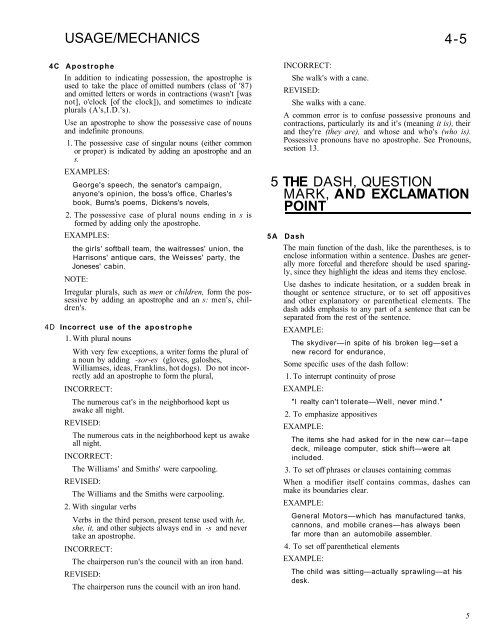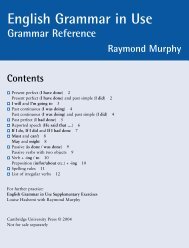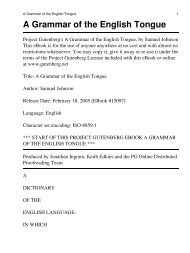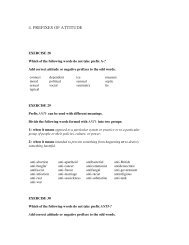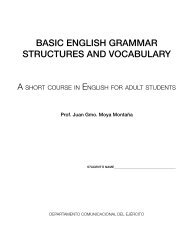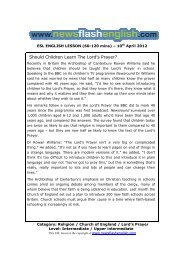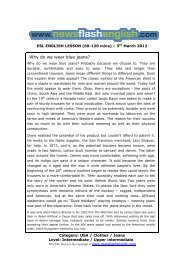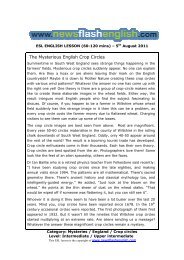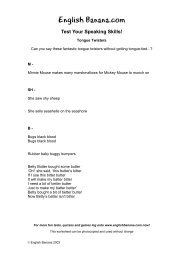TO DOWNLOAD - 75 Pages (928kb - PDF format) - ESL Teachers ...
TO DOWNLOAD - 75 Pages (928kb - PDF format) - ESL Teachers ...
TO DOWNLOAD - 75 Pages (928kb - PDF format) - ESL Teachers ...
You also want an ePaper? Increase the reach of your titles
YUMPU automatically turns print PDFs into web optimized ePapers that Google loves.
USAGE/MECHANICS 4-54C ApostropheIn addition to indicating possession, the apostrophe isused to take the place of omitted numbers (class of '87)and omitted letters or words in contractions (wasn't [wasnot], o'clock [of the clock]), and sometimes to indicateplurals (A's,I.D.'s).Use an apostrophe to show the possessive case of nounsand indefinite pronouns.1. The possessive case of singular nouns (either commonor proper) is indicated by adding an apostrophe and ans.EXAMPLES:George's speech, the senator's campaign,anyone's opinion, the boss's office, Charles'sbook, Burns's poems, Dickens's novels,2. The possessive case of plural nouns ending in s isformed by adding only the apostrophe.EXAMPLES:the girls' softball team, the waitresses' union, theHarrisons' antique cars, the Weisses' party, theJoneses' cabin.NOTE:Irregular plurals, such as men or children, form the possessiveby adding an apostrophe and an s: men's, children's.4D Incorrect use of the apostrophe1. With plural nounsWith very few exceptions, a writer forms the plural ofa noun by adding -sor-es (gloves, galoshes,Williamses, ideas, Franklins, hot dogs). Do not incorrectlyadd an apostrophe to form the plural,INCORRECT:The numerous cat's in the neighborhood kept usawake all night.REVISED:The numerous cats in the neighborhood kept us awakeall night.INCORRECT:The Williams' and Smiths' were carpooling.REVISED:The Williams and the Smiths were carpooling.2. With singular verbsVerbs in the third person, present tense used with he,she, it, and other subjects always end in -s and nevertake an apostrophe.INCORRECT:The chairperson run's the council with an iron hand.REVISED:The chairperson runs the council with an iron hand.INCORRECT:She walk's with a cane.REVISED:She walks with a cane.A common error is to confuse possessive pronouns andcontractions, particularly its and it's (meaning it is), theirand they're (they are), and whose and who's (who is).Possessive pronouns have no apostrophe. See Pronouns,section 13.5 THE DASH, QUESTIONMARK, AND EXCLAMATIONPOINT5A DashThe main function of the dash, like the parentheses, is toenclose in<strong>format</strong>ion within a sentence. Dashes are generallymore forceful and therefore should be used sparingly,since they highlight the ideas and items they enclose.Use dashes to indicate hesitation, or a sudden break inthought or sentence structure, or to set off appositivesand other explanatory or parenthetical elements. Thedash adds emphasis to any part of a sentence that can beseparated from the rest of the sentence.EXAMPLE:The skydiver—in spite of his broken leg—set anew record for endurance,Some specific uses of the dash follow:1. To interrupt continuity of proseEXAMPLE:"I realty can't tolerate—Well, never mind."2. To emphasize appositivesEXAMPLE:The items she had asked for in the new car—tapedeck, mileage computer, stick shift—were altincluded.3. To set off phrases or clauses containing commasWhen a modifier itself contains commas, dashes canmake its boundaries clear.EXAMPLE:General Motors—which has manufactured tanks,cannons, and mobile cranes—has always beenfar more than an automobile assembler.4. To set off parenthetical elementsEXAMPLE:The child was sitting—actually sprawling—at hisdesk.5


